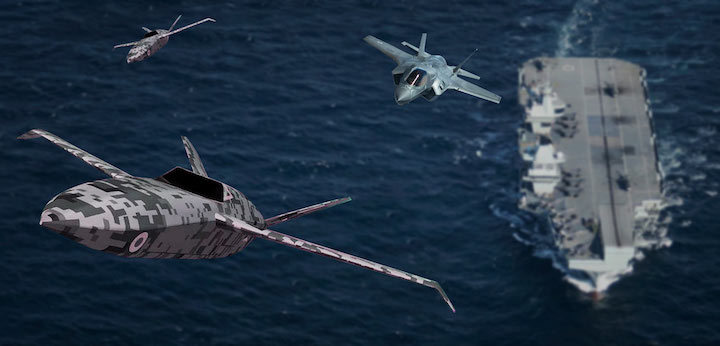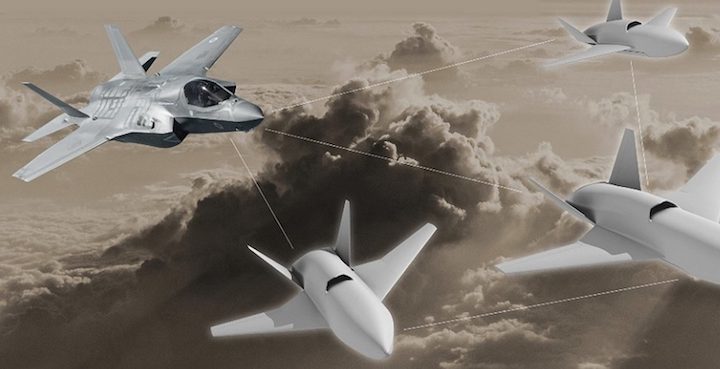15.04.2021

It has emerged that the RN is considering fitting catapults and arrestor gear (cats and traps) to the QEC aircraft carriers to enable the operation of Fixed Wing Unmanned Air Systems. (FWUAS) to complement the F-35B Lightning. Here we examine the implications and the considerable challenges involved.
Overview
In February this year, the MoD issued a Request for Information (RfI) to industry to assess the state of electromagnetic launch and arrestor technology available for fitting to the aircraft carriers. The requirement is for a system capable of launching an aircraft with all-up weight up to 55,000lbs (24,949Kg). This would be inadequate for launching an armed F-35C or F/A-18 Super Hornet (but would be powerful enough to launch the MQ-25 Stingray air-air refuelling UAS). Most importantly, this would enable the operation of a wide range of small-medium sized future UAS. There appears to be an aggressive time schedule, with the RfI demanding a solution that is “sufficiently technically mature to be fitted to a suitable ship from 2023”.
Given the hugely controversial decision to fit cats and traps to the carriers in 2010, followed by a complete reversal of the decision in 2012, it is perhaps surprising to some that the option is under consideration again. The RfI specification has about half the launching power of EMALS originally intended to be fitted to the QEC, and this move should not be seen as the RN reverting to a traditional CATOBAR carrier – its manned aircraft will still land vertically. The costs and delays associated with adding cats and traps to HMS Queen Elizabeth during her initial construction precipitated a return to a more realistic, if less capable, VSTOL solution. Somewhat ironically, given recent developments, the MoD concluded in 2012 that “HMS Queen Elizabeth, if fitted with cats and traps, could not be delivered until 2023 at the earliest”. However, with a planned 50-year service life and an inherently flexible design, it was always thought that modifying the ships for CATOBAR operations remained a possibility for the distant future and was also bound to involve UAS.
The RfI itself does not represent a definite commitment to modifying the carriers but shows the RN is sensibly exploring what may be feasible and affordable. The RN’s Future Maritime Aviation Force vision for 2030 includes project VIXEN, a plan for a medium-sized fixed-wing ‘Loyal Wingman’ UAV to work with F-35. VIXEN would almost certainly require cats and traps and be the initial driving factor behind the urgent move towards a hybrid CATOBAR / VSTOL carrier.
LANCA > Mosquito > Vixen
In 2016 the Defence Science and Technology Laboratory (Dstl) began Project MOSQUITO, to develop a flyable technology UAV demonstrator that could provide ‘additive capability’ for the crewed Typhoon, F-35 and Tempest jets. The project aims to produce air vehicles costing approximately £10M (or about 10% of the cost of F35) and the project optimistically aims to deliver dramatic reductions in cost and development time compared with traditional procurement processes. The UAV will be a transonic ‘loyal wingman’, acting as a force multiplier, adding combat mass and performing reconnaissance, deception and air defence suppression missions. A cheaper, uncrewed UAS is obviously much more ‘attritable’ and could be employed on higher risk missions. The aircraft is expected to be capable of launching air-air missiles, be survivable in contested airspace and ‘low observable’ but lacking more extensive and costly stealth features of the F-35. Mosquito payload capacity is unclear but is estimated to be up to 8,500kg with sufficient fuel for a combat radius similar to the F-35B.
Mosquito is part of the wider Lightweight Affordable Novel Combat Aircraft (LANCA) project begun in 2015 that has now been subsumed by the Future Combat Air System Technology Initiative (FCAS TI). FCAS TI includes several projects, with the Tempest optionally-crewed aircraft at its heart, but is also developing a wide range of advanced defence aerospace technologies. In January 2021, Belfast-based Spirit AeroSystems, including their partner Northrop Grumman UK, was awarded a £30M contract to build the Mosquito prototype which is scheduled to be flying by 2023. LANCA is largely being funded from the additional £1.5Bn allocated to defence research, announced in November 2020.
Official sources have already signposted that LANCA would be carrier-capable. In February 2019, Lord Howe told Parliament “any new combat air system will need to be interoperable with the Carrier Enabled Power Projection (CEPP) programme. The concept phase of the acquisition programme will consider Queen Elizabeth carrier basing for any unmanned force multipliers which may form part of the future combat air system”. In July 2020, ACM Mike Wigston added: “The RAF envisions an aircraft derived from LANCA’s Mosquito phase being used on the Royal Navy’s aircraft carriers alongside F-35B Lightnings”.
The Vixen (FWUAS) is likely to be a derivative, or even identical to the Mosquito UAS and operated by the RAF. Any air vehicle intended for carrier operations would require corrosion-resistant materials and coatings appropriate to the marine environment, together with strengthened landing gear and a hook for arrested landings. Depending on its wingspan, it may also need folding wings to save hangar/deck space. Vixen offers a very attractive opportunity to offset the lack of F-35s (the UK is now expected to cap its purchase a total of somewhere between 60-80 by 2035). When operating from the carrier, Vixen has the potential to be used in a wide range of roles, including combat air patrols (CAP), Reconnaissance (ISTAR), electronic warfare (EW) and acting as a communications relay. It is also of sufficient size to be adapted as an air-air refuelling (AAR) tanker to extend the combat radius of the F-35, although it may prove more cost-effective to buy the dedicated MQ-25 Stingray off the shelf from the US.

-
A crude DSTL image from 2015 showing the LANCA crewed / uncrewed teaming concept designed to increase combat mass.
Launch and recovery options
Where the Aircraft Launch and Recovery Equipment (ALRE) to fit to the carriers may come from is unclear. Although China, Russia, France and India all have an interest or have nascent development programmes for electromagnetic aircraft launch systems for their carriers, only the US Navy has a system at sea right now. The General Atomics EMALS and Advanced Arrestor Gear (AAG) is fitted to the USS Gerald R Ford but has experience serious reliability issues. It can smoothly accelerate a 45,000 kg aircraft up to 130 knots but is highly controllable and can quickly be reconfigured to launch a much lighter aircraft. EMALS performance is gradually improving but even this world-leader it is not yet a fully mature.
Back in 2010-12, during the MoD’s Conversion Development Phase (CDP) for the QEC carriers, two electro-magnetic catapult solutions were considered. GE Coverteam in the UK had developed the EMCAT (Electro-Magnetic CATapult) system, capable of launching aircraft with take-off weights, ranging from 50 kg to more than 32,000 kg. Using slightly different technology, the company had also developed Electro Magnetic Kinetic Induction Technology (EMKIT) variant, primarily UAVs in mind for aircraft weighing up to 11,000kg. EMCAT was described as robust, based on COTS technology and had conducted hundreds of successful launches.
Despite the promise of EMCAT, the MoD considered EMALS the lower risk option and signed a contract with General Atomics worth around £123M for the first EMALS/AAG set. (It has never admitted how much it had to pay in compensation for later cancelling the deal). There is a chance the EMCAT/EMKIT prototypes could be dusted off and resurrected but GE Converteam was not working on aircraft recovery systems. Alternatively, GA could offer an ‘EMALS Lite’ option as they benefit from having accumulated the most experience with electromagnetic aircraft launch of any company in the world. There may be other options available but this is a very specialised requirement and a niche market.
The hybrid carrier
Assuming appropriate ALRE technology is available, then the next hurdle to overcome is how to reconfigure the flight deck to allow CATOBAR operations in a way that does not hamper F-35B VSTOL or rotary-wing flying and minimises the work required on the ships. Although there is a gallery deck below the flight deck with space available to accept catapults and the arrestor gear equipment it will still involve significant surgery. It is important to remember that although the QEC is an ‘adaptable carrier’ this really just amounts to capacity within the ship and no detailed design work on CATOBAR had been done before 2010. Any design work done during the 2010-12 DCP may have limited relevance to the new requirements.
The QEC carriers were designed with reserves of electrical generating capacity which is probably adequate for ‘EMALS Lite’ but there would still be very significant work involved in the integration of the ALRE, power supplies and control systems. HMS Queen Elizabeth will be due to begin her first major refit in 2023 and even if the technology is available and design can be ready in such a short timeframe, this work would undoubtedly add many months to her time in dockyard hands.
The diagram below is a crude mock-up showing the potential options.
Climbing the mountain
The intention to have operational FWUAS flying in support of the F-35B by 2030 is undoubtedly the right direction of travel and the project appears to have a refreshing level of urgency. However, there would be some very large technical and funding challenges both for the aircraft and the ship to overcome first. These include:
- Design and build a carrier-capable, low observable FWUAS from scratch in the UK for a unit cost c£10M.
- Integrate the FWUAS with F-35B.
- Integrate weapons and sensors onto the FWUAS.
- Develop safe carrier operating procedures for FWAS and certify weapons carriage and delivery.
- Develop concept of operations and work up to initial operational capability.
- Continue development, including flying FWUAS in large numbers/swarms.
- Consider FWUAS AAR options to support F-35.
- Find and procure appropriate and reliable electromagnetic launch and arrestor gear systems.
- Re-design the QEC carrier flight deck to support both FWUAS CATOBAR operations while retaining VSTOL and RW flying capabilities (The first such hybrid carrier in the world).
- Conduct major refit of HMS Queen Elizabeth, open up parts of the flight deck and install CATOBAR equipment.
- Integrate CATOBAR equipment with ships systems.
- Conduct sea trials and developmental flying with new systems.
- Integrate logistic support and flight control systems for FWUAS onto the ship.
Should this project succeed, there would be rich rewards in the form of a much more formidable air group. Being able to contemplate these options is also further vindication of the selection of a large and adaptable aircraft carrier design. There is an argument that funds might be better spent on a lower-risk option of buying more F-35B and a few V-22 Ospreys, but perhaps it is sensible to start to prepare now for the future of aviation which is likely to be entirely autonomous.
Quelle: NAVY LOOKOUT
